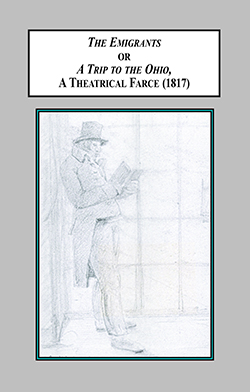Elizabeth B. Bentley’s edition of George Cumberland’s The Emigrants, or, A Trip to the Ohio makes available for the first time this previously unpublished and unperformed play by one of William Blake’s closest associates. Bentley painstakingly edited and transcribed this play, currently existing only in a single fair copy held in special collections at Victoria University (Toronto); the book provides a photographic reproduction of the manuscript following her transcription. Editorial apparatus includes “Characters in the Dramatis Personae,” “The Date of the Farce,” notes on the manuscript and its transcription, descriptions of scene designations and stage directions, and explanations of speech headings, punctuation, capitalization, spelling, and corrected misspellings, all of which are well supported by footnotes. To these Bentley adds an extensive bibliography and an index of names along with two appendices, one listing her addition of parentheses when necessary and the other listing further editorial interventions in Cumberland’s punctuation. Angus Whitehead’s preface locates Cumberland’s play in respect to its antecedents in British drama, while Bentley’s introductory biography contextualizes it within Cumberland’s relationship to the theater and his sources.
The play itself is a short, lighthearted farce, consisting of five scenes that take up 54 manuscript pages and about 69 print pages, or about 12,000-14,000 words. It is about the Acres family and their attempt to emigrate to the United States to start a farm on the Ohio River with the family sheep. The first scene opens at an inn in Falmouth as the Acres are waiting to board their ship, the Rattle-Snake. Scenes 2-4 take place aboard ship as it begins to sail to the United States. The action in the middle of the play consists largely of Mr. Acres’s son, Bobby, trying to steal rum and ale from the ship’s stocks while villainous Major Dandy pursues Acres’s daughter, Miss Acres, with Mrs. Acres’s unwitting complicity. In many ways, Mr. and Mrs. Acres are reminiscent of the Bennets in Austen’s Pride and Prejudice (1813). The play ends with the ship being blown back to Falmouth by a violent storm. Upon arrival the sheep have all been killed in the storm, Major Dandy is arrested, and family members have to appear before a magistrate to affirm that they were not complicit in any of Major Dandy’s crimes. The magistrate finds the Acres innocent, and when Mr. Acres declares that he has given up any intent to emigrate to the United States, the magistrate responds, “He that cannot be happy under the British constitution cannot live contented any where” (86). This single line at the end of a comedy of errors—the play’s humor lies primarily in the bad judgment of some characters and the dishonesty of others—serves as Cumberland’s commentary on British colonial ambitions and on the colonies themselves.
Readers may find conflicting information about the date of composition of Cumberland’s The Emigrants. Robert Brandeis’s appendix to Blake in Our Time (ed. Karen Mulhallen, University of Toronto Press, 2010) sets a date of 1800–05 for the manuscript, but Bentley convincingly argues on the basis of watermarks and references to contemporary events that the play could not have been written before 1817. While the play itself is somewhat imperfectly executed, perhaps comparable to Blake’s An Island in the Moon in that way, this edition provides a valuable contribution to any university serious about supporting the study of eighteenth- or nineteenth-century British or American drama, especially if one is interested in the representation of the United States, its people, and its dialects in British literature. It is also a significant addition to holdings on Cumberland himself and Blake’s circle of acquaintances, and can serve libraries supporting the study of textual editing as a fine example of rigorous attention to detail and full editorial disclosure. Ideally, in the future this edition will contribute important background to an extensive digital humanities project devoted to Cumberland and his manuscripts at Victoria University.
